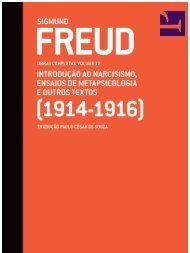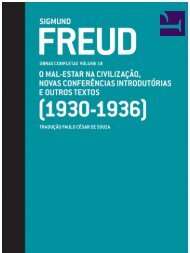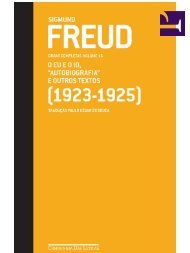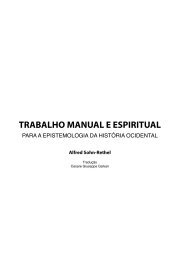Perversion the Social Relation
Perversion the Social Relation
Perversion the Social Relation
- No tags were found...
You also want an ePaper? Increase the reach of your titles
YUMPU automatically turns print PDFs into web optimized ePapers that Google loves.
i£oE. L. McCallumwife Babette—is going to die first, with <strong>the</strong> Dylar experimental drug thatsupposedly assuages <strong>the</strong> fear of death, or even with his choice of objectof study, Hitler. This thanatos drive is, as Freud tells us in Beyond <strong>the</strong>Pleasure Principle, a drive toward stasis, or as Peter Brooks reinscribesit in "Freud's Masterplots," a drive toward <strong>the</strong> completion of <strong>the</strong> narrative.This drive is connected to repetition, which Brooks, in his readingof Freud, posits harnesses energy in <strong>the</strong> service of mastery: "Repetitionworks as a process of binding toward <strong>the</strong> creation of an energeticconstant-state situation which will permit <strong>the</strong> emergence of mastery and<strong>the</strong> possibility of postponement." 4 In o<strong>the</strong>r words, repetition offers <strong>the</strong>promise of control, management, and thus implies a sort of agency.And while <strong>the</strong> very last word of <strong>the</strong> novel is "dead"—and thus renders<strong>the</strong> novel a most fitting example of Brooks's claim that <strong>the</strong> death drivein narrative aims toward <strong>the</strong> conclusion—I do not offer White Noisehere to posit it as a textbook manifestation of drive <strong>the</strong>ory, but insteadfor <strong>the</strong> illusions of individuality and <strong>the</strong> complications of drive <strong>the</strong>orythat <strong>the</strong> novel sketches. Its comparison to Accident, moreover, illustrates<strong>the</strong> limitations of both control and <strong>the</strong> model of individual subjectivity.But first, let us consider <strong>the</strong> underlying <strong>the</strong>oretical model, as elucidatedin Freud.In both Beyond <strong>the</strong> Pleasure Principle and The Ego and <strong>the</strong> Id, Freuddefines two types of instincts: <strong>the</strong> death drive and <strong>the</strong> life drive. The lifedrive or sexual instinct "by bringing about a more far-reaching combinationof <strong>the</strong> particles into which living substance is dispersed, aims atcomplicating life and at <strong>the</strong> same time, of course, preserving it," 5 while<strong>the</strong> death instinct is, as I mentioned already, a drive towards stasis, "thatis, it is a kind of organic elasticity or, to put it ano<strong>the</strong>r way, an expressionof <strong>the</strong> inertia inherent in organic life." 6 Joan Copjec has alreadyremarked on this curious articulation of <strong>the</strong> death drive by Freud, notinghow contradictory it is to reconcile "organic elasticity" and "inertia" assynonyms (a point Freud himself addresses in <strong>the</strong> next sentence, if onlyimplicitly, by commenting on how "strange" it is to think of instinctsas conservative ra<strong>the</strong>r than "impelling towards change"). Leaving aside<strong>the</strong> remarkable appearance of "particles" in Freud's definition of <strong>the</strong> lifedrive, what I find striking about Freud's formulation of thanatos, here,is its presentation as repetition; <strong>the</strong> "that is" and "or, to put it ano<strong>the</strong>rway" signal even out of context that <strong>the</strong> passage reiterates—twice—an








